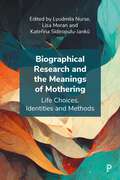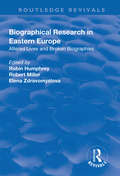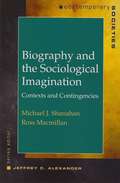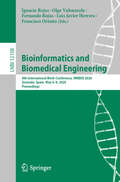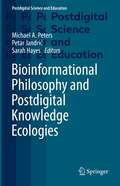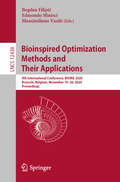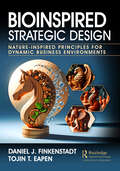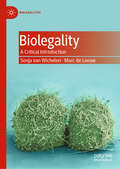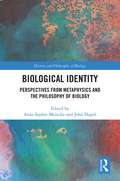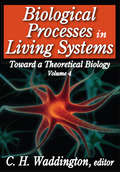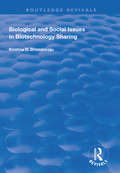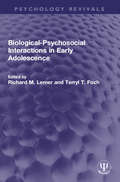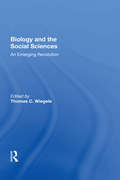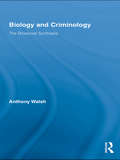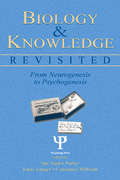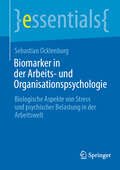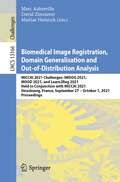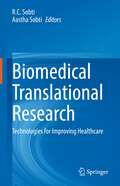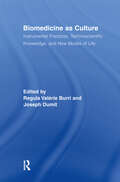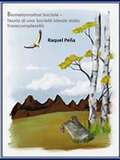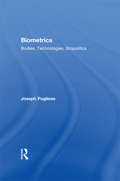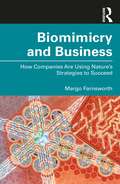- Table View
- List View
Biographical Research and the Meanings of Mothering: Life Choices, Identities and Methods
by Lyudmila Nurse, Lisa Moran and Kateřina Sidiropulu-JankůWhat does mothering mean in different cultures and societies? This book extensively applies biographical and narrative research methods to mothering from international perspectives. This edited collection engages with changing attitudes and approaches to mothering from women’s individual biographical experiences, illuminating how socially anticipated tasks of mothering shaped through interlinking state, media, religious beliefs and broader society are reflected in their identities and individual life choices. Considering trust, rapport, reflexivity and self-care, this collection advances methodological practice in the study of mothers, carers and childless women’s lives.
Biographical Research in Eastern Europe: Altered Lives and Broken Biographies (Routledge Revivals Ser.)
by Robert MillerThis title was first published in 2003. The transition from socialism experienced by the countries of Eastern and Central Europe during the last decade has been recognised as a profound historical watershed. It is only now, however, that the meanings and dimensions of 'post-socialism' are becoming apparent. The use of the 'biographical perspective' in research provides a unique avenue for studying these changes. Biographical Research in Eastern Europe is the only edited volume that brings the work of many of the most advanced and active biographical researchers working on Eastern Europe together in one volume. The book is organized into four parts. 'The Potential of Biographical Research,' explores the methodological issues. Arguments for the appropriateness of the biographical approach as a humanistic perspective are put forward and emphasis is laid on its fruitfulness for research into everyday lives and for the study of identity construction with particular reference to transition. 'Communists, Informers and Dissidents,' deals with the structural features of Soviet regimes, with a particular focus on the problematic divisions between public and private spheres of life. 'The Impact of Social Change,' demonstrates the value of the biographical approach as an instrument for the study of social and cultural change. 'Exile, Migration and Ethnicity,' centres on the problem of constructing and maintaining ethnic identities under repression; a context that can be seen as disturbing life-trajectories and framing the life story. Covering a wide range of 'post-socialist' countries, the chapters are unified by a common research perspective and an informative introduction that identifies common themes across the selections.
Biography and the Sociological Imagination: Contexts and Contingencies
by Michael J. Shanahan Ross MacmillanBecause life course sociology is an imaginative framework, Biography and the Sociological Imagination is less about "what we know" about the life course and more about "how to think" about changing societies and aging by drawing on life course ideas. Drawing from the latest research and using stories of real people, Shanahan and Macmillan spur readers to imagine alternative ways of organizing society and the implications of these alternatives for the biography.
Bioinformatics and Biomedical Engineering: 8th International Work-Conference, IWBBIO 2020, Granada, Spain, May 6–8, 2020, Proceedings (Lecture Notes in Computer Science #12108)
by Ignacio Rojas Francisco Ortuño Olga Valenzuela Fernando Rojas Luis Javier HerreraThis volume constitutes the proceedings of the 8th International Work-Conference on IWBBIO 2020, held in Granada, Spain, in May 2020. The total of 73papers presented in the proceedings, was carefully reviewed and selected from 241 submissions. The papers are organized in topical sections as follows: Biomarker Identification; Biomedical Engineering; Biomedical Signal Analysis; Bio-Nanotechnology; Computational Approaches for Drug Design and Personalized Medicine; Computational Proteomics and Protein-Protein Interactions; Data Mining from UV/VIS/NIR Imaging and Spectrophotometry; E-Health Technology, Services and Applications; Evolving Towards Digital Twins in Healthcare (EDITH); High Performance in Bioinformatics; High-Throughput Genomics: Bioinformatic Tools and Medical Applications; Machine Learning in Bioinformatics; Medical Image Processing; Simulation and Visualization of Biological Systems.
Bioinformational Philosophy and Postdigital Knowledge Ecologies (Postdigital Science and Education)
by Sarah Hayes Michael A. Peters Petar JandrićThe book presents a cross-disciplinary overview of critical issues at the intersections of biology, information, and society. Based on theories of bioinformationalism, viral modernity, the postdigital condition, and others, this book explores two inter-related questions: Which new knowledge ecologies are emerging? Which philosophies and research approaches do they require? The book argues that the 20th century focus on machinery needs to be replaced, at least partially, by a focus on a better understanding of living systems and their interactions with technology at all scales – from viruses, through to human beings, to the Earth’s ecosystem. This change of direction cannot be made by a simple relocation of focus and/or funding from one discipline to another. In our age of the Anthropocene, (human and planetary) biology cannot be thought of without (digital) technology and society. Today’s curious bioinformational mix of blurred and messy relationships between physics and biology, old and new media, humanism and posthumanism, knowledge capitalism and bio-informational capitalism defines the postdigital condition and creates new knowledge ecologies. The book presents scholarly research defining new knowledge ecologies built upon emerging forms of scientific communication, big data deluge, and opacity of algorithmic operations. Many of these developments can be approached using the concept of viral modernity, which applies to viral technologies, codes and ecosystems in information, publishing, education, and emerging knowledge (journal) systems. It is within these overlapping theories and contexts, that this book explores new bioinformational philosophies and postdigital knowledge ecologies.
Bioinspired Optimization Methods and Their Applications: 9th International Conference, BIOMA 2020, Brussels, Belgium, November 19–20, 2020, Proceedings (Lecture Notes in Computer Science #12438)
by Massimiliano Vasile Edmondo Minisci Bogdan FilipičThis book constitutes the refereed proceedings of the 9th International Conference on Bioinspired Optimization Methods and Their Applications, BIOMA 2020, held in Brussels, Belgium, in November 2020. The 24 full papers presented in this book were carefully reviewed and selected from 68 submissions. The papers in this BIOMA proceedings specialized in bioinspired algorithms as a means for solving the optimization problems and came in two categories: theoretical studies and methodology advancements on the one hand, and algorithm adjustments and their applications on the other. Due to the Corona pandemic BIOMA 2020 was held as a virtual event.
Bioinspired Strategic Design: Nature-Inspired Principles for Dynamic Business Environments
by Daniel J. Finkenstadt Tojin T. EapenOrganizations are commonly thrust into hostile operating environments where they are required to make strategic decisions that involve significant and costly tradeoffs. Such hostile environments may be endemic such as an economic recession or idiosyncratic such as a predatory action by an adversary. Many features of such hostile environments parallel those of living organisms that also demonstrate fine-tuned strategies to improve their survivability under adverse conditions. How can organizations use these “bioinspired strategies” to survive, and even potentially innovate? This book shows that the same three capabilities essential for the survival of living organisms in harsh environments – efficiency, resilience, and prominence – are also critical for organizations in their process of navigating through their own hostile environments. Throughout the book, the authors provide organizational executives with a systematic framework for thinking about strategic decision-making in a hostile environment leaning on analysis of real-world cases to draw out ontologies and methods for guiding their teams through disruptions, change management, innovation, and process improvements. In the first part, organizations are provided with a systematic approach to analyzing three survivability influences – forces, resources, and observers and their interrelationships. While all three influences are active across all organisms (and organizations), the exact nature of their interrelationship and the significance of each influence are unique to every organism (or organization). The framework helps organizations nail down the specific features of their operating environment that can help or hinder survivability by analyzing the three influences. Organizations can respond to external influences by developing three-pronged capabilities – efficiency, resilience, and prominence (ERP) – that respond to the three survivability influences. Organizations often struggle with identifying the appropriate strategies to apply under different conditions. Fortunately, nature provides several mechanisms that can be analogically applied to guide business strategies. The book contains many illustrations and examples of strategic principles observed among living organisms that can help an organization develop ERP capability. Finally, the book introduces seven strategic design heuristics – Combination, Elimination, Separation, Segmentation, Replication, Dynamics, and Maximization – observed in a living system that can be flexibly utilized to generate ideas to achieve strategic ends.
Biolegality: A Critical Introduction (Biolegalities)
by Marc de Leeuw Sonja van WichelenThis book provides a comprehensive analysis of the empirical and theoretical problems posed by the encounter between law and biology in the twenty-first century. How does biotechnology and new bioscientific knowledge affect our legal institutions, our sense of justice, and our ways of relating to one another? To answer these questions, authors Marc de Leeuw and Sonja van Wichelen examine the complex and often contested ways in which biotechnology and biological knowledge are reworked by, with, and against legal knowledge. As this book shows, recent developments in the life sciences—including molecular biology, immunology, and the neurosciences—and their applications in forensics, medicine, and agriculture test longstanding legal forms, such as property, personhood, parenthood, and (collective) identity, ultimately constituting the current field of “biolegality.” The authors argue that these biolegal contestations represent philosophical and anthropological challenges to existing understandings of exchange, self, kinship, and community. By addressing how biology and law inform new ways of relating and knowing, the book proposes a programmatic intervention, asserting the pivotal role the study of biolegality plays in advancing social and political theory.
Biological Identity: Perspectives from Metaphysics and the Philosophy of Biology (History and Philosophy of Biology)
by Anne Sophie MeinckeAnalytic metaphysics has recently discovered biology as a means of grounding metaphysical theories. This has resulted in long-standing metaphysical puzzles, such as the problems of personal identity and material constitution, being increasingly addressed by appeal to a biological understanding of identity. This development within metaphysics is in significant tension with the growing tendency amongst philosophers of biology to regard biological identity as a deep puzzle in its own right, especially following recent advances in our understanding of symbiosis, the evolution of multi-cellular organisms and the inherently dynamical character of living systems. Moreover, and building on these biological insights, the broadly substance ontological framework of metaphysical theories of biological identity appears problematic to a growing number of philosophers of biology who invoke process ontology instead. This volume addresses this tension, exploring to what extent it can be dissolved. For this purpose, the volume presents the first selection of essays exclusively focused on biological identity and written by experts in metaphysics, the philosophy of biology and biology. The resulting cross-disciplinary dialogue paves the way for a convincing account of biological identity that is both metaphysically constructive and scientifically informed, and will be of interest to metaphysicians, philosophers of biology and theoretical biologists.
Biological Processes in Living Systems: Toward A Theoretical Biology (Toward a Theoretical Biology)
by C. H. WaddingtonBiological Processes in Living Systems is the fourth and final volume of the Toward a Theoretical Biology series. It contains essays that deal in detail with particular biological processes: morphogenesis of pattern, the development of neuronal networks, evolutionary processes, and others. The main thrust of this volume brings relevance to the general underlying nature of living systems. Faced with trying to understand how the complexity of molecular microstates leads to the relative simplicity of phenome structures, Waddington-on behalf of his colleagues-stresses on the structure of language as a paradigm for a theory of general biology. This is language in an imperative mood: a set of symbols, organized by some form of generative grammar, making possible the conveyance of commands for action to produce effects on the surroundings of the emitting and the receiving entities. "Biology," he writes, "is concerned with algorithm and program." Among the contributions in this volume are: "The Riemann-Hugoniot Catastrophe and van der Waals Equation," David H. Fowler; "Differential Equations for the Heartbeat and Nerve Impulse," E. Christopher Zeeman; "Structuralism and Biology," Rene Thom; "The Concept of Positional Information and Pattern Formation," Lewis Wolpert; "Pattern Formation in Fibroblast Cultures," Tom Elsdale; "Form and Information," C. H. Waddington; "Organizational Principles for Theoretical Neurophysiology," Michael A. Arbib; "Stochastic Models of Neuroelectric Activity," Jack D. Cowan. Biological Processes in Living Systems is a pioneering volume by recognized leaders in an ever-growing field.
Biological and Social Issues in Biotechnology Sharing (Routledge Revivals)
by Krishna R. DronamrajuFirst published in 1998, this was the first book to present a comprehensive summary of both the global as well as institutional issues which are involved in biotechnology sharing. It covers the controversial subject of intellectual property rights (IPR) and the patenting of new discoveries in genetic knowledge in both agriculture and the human genome. One controversial issue is the creation of public and private DNA sequencing data bases. Of special interest is the sharing of biotechnology between the developed (rich) and developing (poor) nations. A related topic which requires immediate attention is the exploitation of biodiversity in the developing countries and the resulting extinction of rare species. Sharing or transferring biotechnology and its applications between institutions or different countries raises numerous ethical and moral dilemmas. A comprehensive summary of these issues is presented in this book.
Biological-Psychosocial Interactions in Early Adolescence (Psychology Revivals)
by Richard M. Lerner; Terryl T. FochFirst published in 1987, Biological-Psychosocial Interactions in Early Adolescence explores the mutually - influential relations between biological and psychosocial variables as the basis for development in the early portions of the adolescent period and, in fact, across the entire life span. The volume introduces key conceptual and methodological issues that are raised by the study of biological-psychosocial interrelations. It provides key foundations for the research conducted in major laboratories in USA back in 1980s. It also provides the results from these laboratories and their progress at that time. This book will be an essential read for scholars and researchers of psychology, behavioural science, and sociology.
Biology And The Social Sciences: An Emerging Revolution
by Thomas C. WiegeleExciting new developments in behavioral biology are creating an intellectual revolution in the study of human behavior and are causing social scientists to reassess the ways in which they approach their disciplines. This book examines how these new findings are likely to transform and shape anthropology, sociology, economics, and political science in the coming decade. The book begins with an overview of the rapidly changing relationship between biological and social studies. In successive sections, well-known social scientists, biologists, and philosophers address the theoretical challenges involved in incorporating material from sociobiology, ecology, genetics, and psychophysiology into their own disciplines' approaches to the analysis of human behavior. The concluding chapters examine specific methodological problems and related issues.
Biology and Criminology: The Biosocial Synthesis (Routledge Advances in Criminology)
by Anthony WalshNumerous criminologists have noted their dissatisfaction with the state of criminology. The need for a new paradigm for the 21st century is clear. However, many distrust biology as a factor in studies of criminal behavior, whether because of limited exposure or because the orientation of criminology in general has a propensity to see it as racist, classist, or at least illiberal. This innovative new book by noted criminologist Anthony Walsh dispels such fears, examining how information from the biological sciences strengthens criminology work and both complements and improves upon traditional theories of criminal behavior. With its reasoned case for biological science as a fundamental tool of the criminologist, Walsh's groundbreaking work will be required reading for all students and faculty within the field of criminology.
Biology and Knowledge Revisited: From Neurogenesis to Psychogenesis (Jean Piaget Symposia Series)
by Sue Taylor Parker Constance Milbrath Jonas LangerBased on the Annual Symposium of the Jean Piaget Society, Biology and Knowledge Revisited focuses on the classic issue of the relationship between nature and nurture in cognitive and linguistic development, and their neurological substrates. Contributors trace the history of ideas concerning the relationship between evolution and development, and bring powerful new conceptual systems and research data to bear on understanding the problem of experience-contingent brain development and evolution. They focus on processes of phenotype construction - which fill the gap between genes and behavior - and demonstrate that evolutionary psychological models of innate mental modules are incompatible with what is known about these processes. This book presents exciting new approaches to the development and evolution of cognitive and linguistic abilities. Returning to the broad evolutionary theme of a previous meeting, the symposium focused on specifically constructivist approaches to neurogenesis and language acquisition, and their evolution. It was organized around ideas about the relationship between development and evolution raised in Piaget's books. Research in this arena has yielded cutting-edge insight into behavioral influences on brain plasticity. Two of its subthemes run throughout - a critique of modularity models popular among evolutionary psychologies and the prescient yet flawed nature of Piaget's critique of the modern synthesis of evolution. As a result, Biology and Knowledge Revisited is intended for developmental psychologists, psycholinguists, biological anthropologists, evolutionary psychologists, and philosophers of science.
Biomarker in der Arbeits- und Organisationspsychologie: Biologische Aspekte von Stress und psychischer Belastung in der Arbeitswelt (essentials)
by Sebastian OcklenburgDieses essential gibt einen Überblick über Biomarker-Forschung in der Arbeits- und Organisationspsychologie. Dabei werden die zentralen Biomarker und Methoden zur Erfassung von Biomarkern erläutert. Der Autor beleuchtet spezifisch relevante Biomarker für psychische Erkrankungen im Kontext der Arbeitswelt sowie Biomarker für psychische Belastungsfolgen der Arbeit wie Burn-out. Das essential endet mit einer praxisorientierten Erläuterung organisationaler und finanzieller Aspekte von biopsychologischer Forschung in der Arbeitswelt.
Biomedical Image Registration, Domain Generalisation and Out-of-Distribution Analysis: MICCAI 2021 Challenges: MIDOG 2021, MOOD 2021, and Learn2Reg 2021, Held in Conjunction with MICCAI 2021, Strasbourg, France, September 27–October 1, 2021, Proceedings (Lecture Notes in Computer Science #13166)
by Marc Aubreville David Zimmerer Mattias HeinrichThis book constitutes three challenges that were held in conjunction with the 24th International Conference on Medical Image Computing and Computer-Assisted Intervention, MICCAI 2021, which was planned to take place in Strasbourg, France but changed to an online event due to the COVID-19 pandemic. The peer-reviewed 18 long and 9 short papers included in this volume stem from the following three biomedical image analysis challenges: Mitosis Domain Generalization Challenge (MIDOG 2021), Medical Out-of-Distribution Analysis Challenge (MOOD 2021), and Learn2Reg (L2R 2021). The challenges share the need for developing and fairly evaluating algorithms that increase accuracy, reproducibility and efficiency of automated image analysis in clinically relevant applications.
Biomedical Image Registration: 9th International Workshop, WBIR 2020, Portorož, Slovenia, December 1–2, 2020, Proceedings (Lecture Notes in Computer Science #12120)
by Orcun Goksel Žiga Špiclin Jamie McClelland Jan KybicThis book constitutes the refereed proceedings of the 9th International Workshop on Biomedical Image Registration, WBIR 2020, which was supposed to be held in Portorož, Slovenia, in June 2020. The conference was postponed until December 2020 due to the COVID-19 pandemic. The 16 full and poster papers included in this volume were carefully reviewed and selected from 22 submitted papers. The papers are organized in the following topical sections: Registration initialization and acceleration, interventional registration, landmark based registration, multi-channel registration, and sliding motion.
Biomedical Translational Research: Technologies for Improving Healthcare
by R. C. Sobti Aastha SobtiThis book, which is the first volume of Biomedical Translational Research, summarizes emerging technologies in healthcare. The book reviews the advancements in biomedical sciences in genomics, immunology, stem cell, tissue engineering, nanotechnology, computational and structural biology, biomedical engineering, and telemedicine biology. The book highlights the applications of artificial intelligence in the diagnosis of infectious diseases and examines the role of system biology approaches for understanding human complexity, variability, and its influence on health and diseases. It presents the applications of flow cytometry in monitoring the progression and treatment of disease. It covers emerging technologies in cancer research, including CRISPR-Cas9, NGS, and nanotechnology. This book is a useful source of information for clinical researchers, basic scientists, biomedical engineers, and computational biologists.
Biomedicine as Culture: Instrumental Practices, Technoscientific Knowledge, and New Modes of Life (Routledge Studies in Science, Technology and Society)
by Joseph Dumit Regula Valérie BurriThis volume offers interdisciplinary perspectives on contemporary biomedicine as a cultural practice. It brings together leading scholars from cultural anthropology, sociology, history, and science studies to conduct a critical dialogue on the culture(s) of biomedical practice, discussing its epistemic, material, and social implications. The essays look at the ways new biomedical knowledge is constructed within hospitals and academic settings and at how this knowledge changes perceptions, material arrangements, and social relations, not only within clinics and scientific communities, but especially once it is diffused into a broader cultural context.
Biometamorfosi Sociale: Teoria di una società ideale dalla transcomplessità
by Raquel PeñaBiometamorfosi sociale di Raquel Peña. Teoria di una società ideale dalla transcomplessità. Siamo tutti capaci di trasformarci. Siamo tutti capaci di trasformarci. La società richiede che gli individui che la compongono prendano coscienza dell'importanza di essere persone migliori, sotto una concezione etica, morale e spirituale. Questo libro mostra i risultati di un'indagine condotta in un settore popolare venezuelano dalla percezione degli attori sociali e come la conoscenza che possiedono come fonte generatrice emerga dalle loro esperienze. È da questa ricerca che è nata la teoria: Biometamorfosi Sociale.
Biometric Identification, Law and Ethics (SpringerBriefs in Ethics)
by Seumas Miller Marcus SmithThis book is open access. This book undertakes a multifaceted and integrated examination of biometric identification, including the current state of the technology, how it is being used, the key ethical issues, and the implications for law and regulation. The five chapters examine the main forms of contemporary biometrics–fingerprint recognition, facial recognition and DNA identification– as well the integration of biometric data with other forms of personal data, analyses key ethical concepts in play, including privacy, individual autonomy, collective responsibility, and joint ownership rights, and proposes a raft of principles to guide the regulation of biometrics in liberal democracies.Biometric identification technology is developing rapidly and being implemented more widely, along with other forms of information technology. As products, services and communication moves online, digital identity and security is becoming more important. Biometric identification facilitates this transition. Citizens now use biometrics to access a smartphone or obtain a passport; law enforcement agencies use biometrics in association with CCTV to identify a terrorist in a crowd, or identify a suspect via their fingerprints or DNA; and companies use biometrics to identify their customers and employees. In some cases the use of biometrics is governed by law, in others the technology has developed and been implemented so quickly that, perhaps because it has been viewed as a valuable security enhancement, laws regulating its use have often not been updated to reflect new applications. However, the technology associated with biometrics raises significant ethical problems, including in relation to individual privacy, ownership of biometric data, dual use and, more generally, as is illustrated by the increasing use of biometrics in authoritarian states such as China, the potential for unregulated biometrics to undermine fundamental principles of liberal democracy. Resolving these ethical problems is a vital step towards more effective regulation.
Biometrics: Bodies, Technologies, Biopolitics (Routledge Studies in Science, Technology and Society)
by Joseph PuglieseBiometric technologies, such as finger- or facial-scan, are being deployed across a variety of social contexts in order to facilitate and guarantee identity verification and authentication. In the post-9/11 world, biometric technologies have experienced an extraordinary period of growth as concerns about security and screening have increased. This book analyses biometric systems in terms of the application of biopolitical power – corporate, military and governmental – on the human body. It deploys cultural theory in examining the manner in which biometric technologies constitute the body as a target of surveillance and as a data-information object. The book thereby provides a comprehensive overview and critical analysis of both the local and global ramifications of biometric technologies.
Biomimicry and Business: How Companies Are Using Nature's Strategies to Succeed
by Margo FarnsworthBiomimicry, the practice of observing then mimicking nature’s strategies to solve business challenges, offers a path to healthy profit while working in partnership, and even reciprocity, with the natural world. Other books have described biomimicry, its uses, and its benefits. This book shows readers how to create their own biomimetic or bioinspired solutions with clear benefits to the bottom line, the environment, and people. Fashioned through storytelling, this book blends snapshots of five successful companies – Nike, Interface, Inc., PAX Scientific, Sharklet Technologies, and Encycle – which decided to partner with nature by deploying biomimicry. The book details how they discovered the practices, introduced them to staff, engaged in the process, and measured outcomes. The book concludes with challenges for readers to determine their own next steps in business and offers practical and useful resources to get there. By revealing the stories of each professional’s journey with lessons they learned, then providing resources and issuing a challenge and pathway to do business better, this book serves as a tool for entrepreneurs, seasoned professionals, and students to emulate nature’s brilliance, apply it at work, and contribute to a healthier, more prosperous world.
Biophilic Cities for an Urban Century: Why nature is essential for the success of cities
by Timothy Beatley Robert McDonaldThis book argues that, paradoxically, at their moment of triumph and fastest growth, cities need nature more than ever. Only if our urban world is full of biophilic cities will the coming urban century truly succeed. Cities are quintessentially human, the perfect forum for interaction, and we are entering what could justly be called the urban century, the fastest period of urban growth in human history. Yet a growing body of scientific literature shows that the constant interaction, the hyper-connectedness, of cities leads to an urban psychological penalty. Nature in cities can be solution to this dilemma, allowing us to have all the benefits of our urban, connected world yet also have that urban home be a place where humanity can thrive. This book presents best practices and case studies from biophilic design, showing how cities around the world are beginning to incorporate nature into their urban fabric. It will be a valuable resource for scholars and professionals working in the area of sustainable cities.
